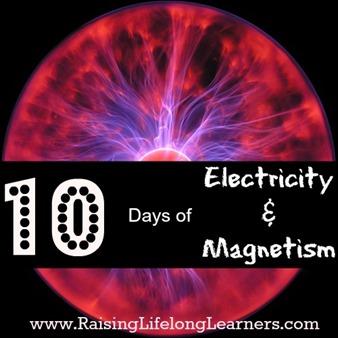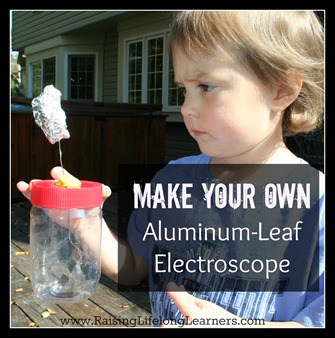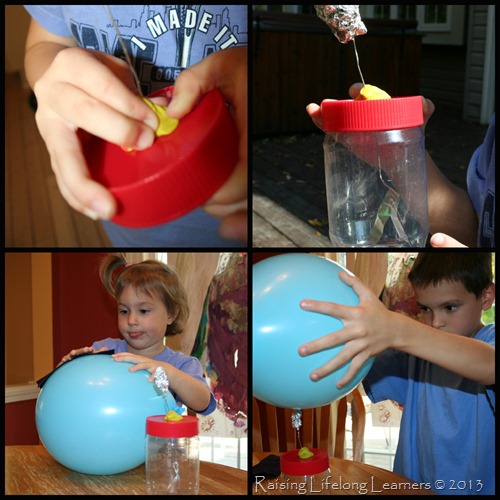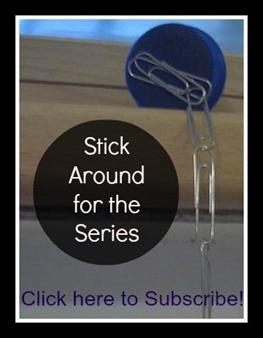Make Your Own Aluminum-Leaf Electroscope
Welcome back to 10-Days of Electricity and Magnetism, part of the iHomeschool Network Spring Hopscotch. If you’re new here, you might want to read from the beginning as each post builds upon the last to help you pull together a cohesive unit study for your kids. You might also want to take a minute to subscribe by email so you don’t miss a post.
So far this week, we’ve talked briefly about big developments in the history of electricity and magnetism and played around with static electricity. Today we’re going to build an aluminum-leaf electroscope that can actually detect electrical charges in object you have lying around.
William Gilbert invented the first electroscope in 1600, calling it a versorium. It had a metal needle that moved freely inside and turned towards charged objects when they came near.
Over the next two-hundred years, the electroscope went through many different changes, all with the same goal in mind – create the best instrument for detecting electrical charges in objects. First, a hanging thread was added that was attracted to charged objects nearby. Then, tiny balls made out of pith {plant fiber} were added to the ends of the thread to make it easier to see when the thread moved toward charges. They would become charged when they got close to an object, and since they now had the same charge as whatever they were near, they would repel. How far apart they were after repelling indicated how strong the charge was.
In the late 1700s, the electroscope was fine-tuned further. Gold foil leaves were used because the gold was more sensitive than the pith or thread.
In this activity, we can use aluminum foil to replace the gold foil. You’ll be able to use your electroscope to check for sources of static electricity around you.
You’ll need:
- jar with a lid
- clay
- aluminum foil
- scissors
- metal paper clip
- a balloon
- a square of wool or flannel
Try it this way:
- Straighten the paper clip out.
- Poke a hole in the lid of the jar big enough for the paper clip to slide through.
- Push the paper clip through the hole in the jar lid and bend the end that is on the underside of the jar into an ‘L’ shape.
- Form your clay around the clip on the outside and inside of the jar lid to secure it and make sure it is sealed tight.
- Take a piece of aluminum foil and roll it into a 1-inch ball and put it on the straight {outside} end of the paper clip.
- Use the scissors to cut a strip of foil about 5 inches by 1/2 inch. Fold it in half and set it on the ‘L’ shaped end of the paper clip.
- Put the lid on the jar and close it tightly, sealing the strip of aluminum foil inside the jar.
- Rub the square of flannel or wool vigorously on the balloon and hold it near the foil ball. Look at the aluminum strip inside the jar. The ends should move away from each other due to the static electricity on the balloon.
Look around the house. What else might have a charge? Write a list of things to test with your electroscope, and make a prediction as to whether or not it holds static electricity. Then, test it with your electroscope and write down whether or not your hypothesis was correct. You can do this in a science notebook or on the printable below.
We had a lot of fun with this, and were surprised by some of our results. Making an electroscope is another way to explore static electricity and learn more about the electrical charges that surround us. Are you enjoying this study? I hope so. Take a minute to sign up for emails by clicking the picture below if you haven’t done so already. There are more unit studies like this coming in the future, along with lots of great content.
Have you taken time to check out some of the other 10-Day series in the iHomeschool Network’s Spring Hopscotch? I’m having a great time exploring topics like Using Games in School and 10 Days of Raising Boys.
Thanks for coming by today. I hope to see you tomorrow when we explore simple circuitry.






